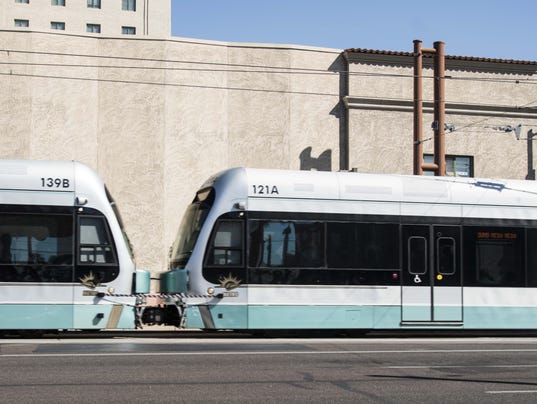Phoenix spends $125K to help homeless on light rail

Phoenix AX Dec 9 2017 With homelessness on the rise across the Valley and the nation, Phoenix residents are seeing the impact in neighborhoods, parks and the light rail.
The Phoenix City Council approved a transit-specific expansion to Phoenix CARES, a program established earlier this year to increase services and combat the impact of homelessness, like blight and trespassing.
The city already has deployed four homeless outreach teams in the community to engage and transport people experiencing homelessness to emergency shelters, detox facilities, hospitals and other services.
But this new effort will focus specifically on the light rail and its stations.
The number of people who are homeless and not in shelters climbed by almost 60 percent in the past two years, according to Maricopa County’s 2017 “point-in-time” count. More than 70 percent of those individuals are in Phoenix.
The negative side issues of homelessness have trickled into Phoenix’s public transportation systems. According to a city staff report, resident complaints about homelessness on the light rail have increased “significantly” in the past several months.
Albert Santana, the city’s director of high-capacity transit, said the resident calls about homelessness on the light rail take many different forms, with some reporting safety and security concerns and others just noting an increase in people who appear homeless.
“(Homelessness is) a very important item for our residents and the city so we wanted to do our part to step up and provide resources on our asset and provide services in a positive way,” Santana said.
The transit department is paying for the new $125,000 outreach team by cutting back on security at park-and-ride locations.
Currently, security guards patrol most of the park-and-ride lots all day. Since these lots are mostly used by commuters, the city decided to keep the guards stationed in the lots full-time during peak morning and evening hours, but have them patrol on a roving basis during less-busy hours.
The city hired Community Bridges, a local nonprofit, to provide the outreach teams.
Santana said the transit department doesn’t have the training and experience needed to connect with people experiencing homelessness, but Community Bridges can provide “sensitive engagement.”
Nate Smith, community engagement manager at Phoenix Rescue Mission, said the light rail system is “big-time impacted by homelessness” because people who live on the streets often use the public transportation system.
There’s definitely a need for people to be offered services there,” he said.
Smith, whose organization provides emergency shelter, addiction programs and other services, said he supports the city’s new dedication to increasing homeless outreach in the community.
He said consistent outreach is essential to eventually getting people into needed services.
He said many people may not engage on the first attempt, but the chance of connecting someone with needed help increases if experienced individuals continue reaching out.
“Outreach is a good thing for the city to focus its resources,” Smith said.
The light rail is owned and operated by Valley Metro, but the transportation authority relies heavily on the cities the rail line traverses — Phoenix, Tempe and Mesa — to assist with safety and security, according to Hillary Foose, Valley Metro’s director of communication and strategic initiatives.
“That’s the way it’s always worked — even when we first started,” she said.
Other programs funded and operated through partnerships with the cities include jaywalking enforcement campaigns and additional police enforcement near stations, Foose said.
Phoenix Police Department’s Traffic Enforcement Unit provides eight extra-duty police officers focused on light rail.
She said Valley Metro has also met regularly with social services providers, including Community Bridges, to determine how to bring homelessness outreach to the light rail stations.
“Phoenix’s program is definitely in line with some of the initiatives we’re doing with Valley Metro,” Foose said.
Valley Metro recently introduced its “Respect the Ride” campaign, which includes a stricter passenger code of conduct that prohibits unruly behavior and gives light-rail security guards more flexibility to remove passengers.
“(Phoenix’s program) will be a great compliment of what we’re trying to accomplish with Respect the Ride,” Foose said.
AZCentral



